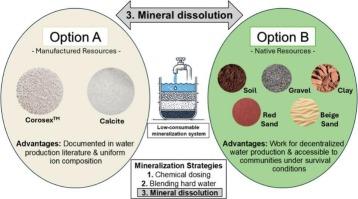Water mineralization in resource-limited locations
IF 6.7
2区 工程技术
Q1 ENGINEERING, CHEMICAL
引用次数: 0
Abstract
Water scarcity is a global issue affecting communities worldwide, as seen in events such as the 2018 Cape Town water crisis, the 2021 Quebec water restrictions, the recent water shortage in Catalonia, and the Neskantaga First Nations' 30-year struggle without drinkable running water. This highlights the urgent need for sustainable water resource management. Alternative water sources, such as reverse osmosis, rainwater, or atmospheric water harvesting offer promising solutions, though challenges remain concerning the mineralization these types of waters due to their low concentrations of essential minerals like calcium and magnesium. While conventional mineralization methods exist, this study explores an alternative approach by emphasizing the use of native materials to favor resource-constrained communities with limited access to commercial consumables. To assess water mineral dissolution, this work tested five native materials (soil, beige sand, red sand, clay, and gravel), two commercial materials (calcite and Corosex™), and a commercial remineralization filter. Results show that soil (at a dosage of 0.03 g/mL) and red sand (0.25 g/mL) have potential as native materials for adjusting and achieving optimal levels of water hardness (182 mg CaCO3/L and 265 mg CaCO3/L, respectively). Furthermore, red sand contains a higher proportion of magnesium ions, an essential nutrient with recognized health benefits, ensuring that World Health Organization mineralization guidelines are met. These native materials show promise for developing a low-consumable mineralization system that could be integrated with non-conventional water technologies, to meet the goal of providing water quality to communities in need, namely in survival conditions.

资源有限地区的水矿化
水资源短缺是一个影响全球社区的全球性问题,例如2018年开普敦水危机、2021年魁北克限水、加泰罗尼亚最近的水资源短缺,以及内斯坎塔加第一民族30年来没有饮用水的斗争。这突出了对可持续水资源管理的迫切需要。替代水源,如反渗透、雨水或大气集水提供了有希望的解决方案,尽管由于这些类型的水的钙和镁等必需矿物质浓度低,因此在矿化方面仍然存在挑战。虽然存在传统的矿化方法,但本研究探索了一种替代方法,强调使用天然材料来支持资源受限的社区,这些社区获得商业消耗品的机会有限。为了评估水矿物溶解,本工作测试了五种天然材料(土壤、米色砂、红砂、粘土和砾石)、两种商业材料(方解石和Corosex™)和一个商业再矿化过滤器。结果表明,土壤(0.03 g/mL)和红砂(0.25 g/mL)有潜力作为调节和达到最佳水硬度水平的天然材料(分别为182 mg CaCO3/L和265 mg CaCO3/L)。此外,红砂含有较高比例的镁离子,这是一种公认有益健康的基本营养素,确保符合世界卫生组织的矿化准则。这些天然材料有望开发出一种低消耗的矿化系统,可以与非常规水技术相结合,以实现为有需要的社区提供优质水的目标,即在生存条件下。
本文章由计算机程序翻译,如有差异,请以英文原文为准。
求助全文
约1分钟内获得全文
求助全文
来源期刊

Journal of water process engineering
Biochemistry, Genetics and Molecular Biology-Biotechnology
CiteScore
10.70
自引率
8.60%
发文量
846
审稿时长
24 days
期刊介绍:
The Journal of Water Process Engineering aims to publish refereed, high-quality research papers with significant novelty and impact in all areas of the engineering of water and wastewater processing . Papers on advanced and novel treatment processes and technologies are particularly welcome. The Journal considers papers in areas such as nanotechnology and biotechnology applications in water, novel oxidation and separation processes, membrane processes (except those for desalination) , catalytic processes for the removal of water contaminants, sustainable processes, water reuse and recycling, water use and wastewater minimization, integrated/hybrid technology, process modeling of water treatment and novel treatment processes. Submissions on the subject of adsorbents, including standard measurements of adsorption kinetics and equilibrium will only be considered if there is a genuine case for novelty and contribution, for example highly novel, sustainable adsorbents and their use: papers on activated carbon-type materials derived from natural matter, or surfactant-modified clays and related minerals, would not fulfil this criterion. The Journal particularly welcomes contributions involving environmentally, economically and socially sustainable technology for water treatment, including those which are energy-efficient, with minimal or no chemical consumption, and capable of water recycling and reuse that minimizes the direct disposal of wastewater to the aquatic environment. Papers that describe novel ideas for solving issues related to water quality and availability are also welcome, as are those that show the transfer of techniques from other disciplines. The Journal will consider papers dealing with processes for various water matrices including drinking water (except desalination), domestic, urban and industrial wastewaters, in addition to their residues. It is expected that the journal will be of particular relevance to chemical and process engineers working in the field. The Journal welcomes Full Text papers, Short Communications, State-of-the-Art Reviews and Letters to Editors and Case Studies
 求助内容:
求助内容: 应助结果提醒方式:
应助结果提醒方式:


